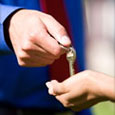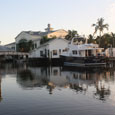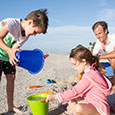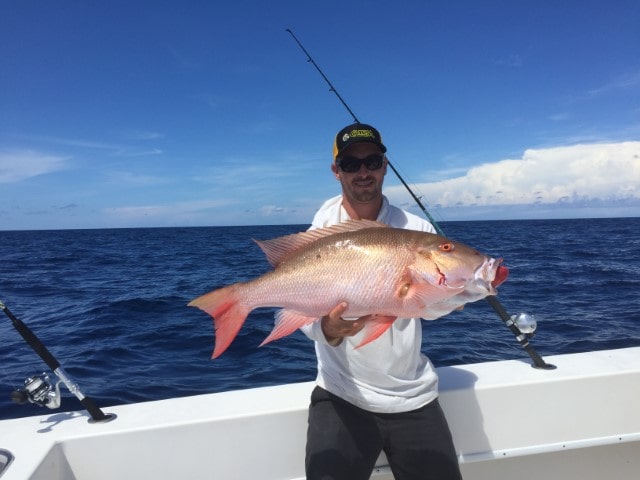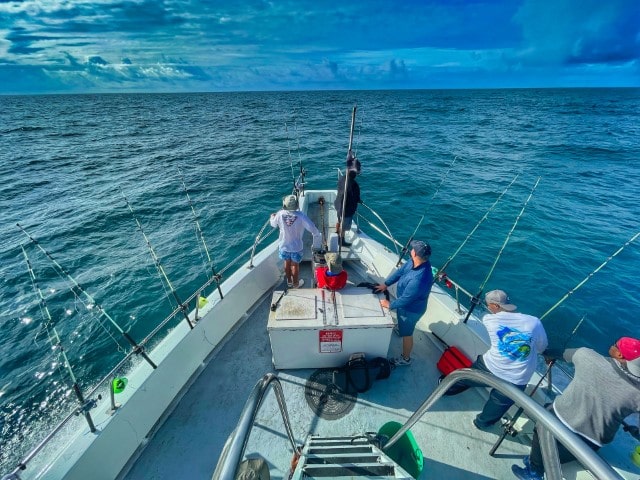
Posted by
Whether you’re a native or an out-of-town visitor, it’s no secret that fishing is a favorite pastime on the Gulf coast. Perhaps you are wondering where to go for the best deep-sea fishing in Florida? You’re in luck. We will share all our local knowledge and reveal the best fishing spots so that you can have an unforgettable experience in Southwest Florida.
Deep-sea fishing is a thrilling experience full of valuable lessons and memorable adventures. The best deep-sea fishing in Florida happens in water depths of over 100 feet, allowing you to catch fish that you won’t find near the shore. So, let’s get into the open waters and see why Florida is considered the “Fishing Capital of the World.”
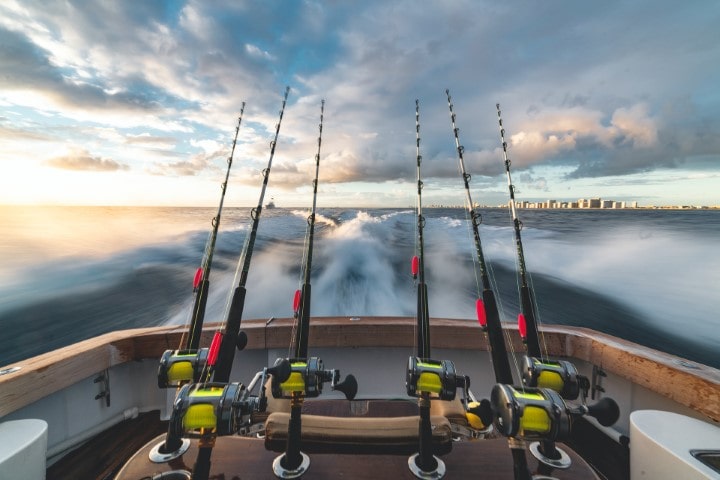
What Is the Best Time of Year to Go Deep-Sea Fishing in Florida?
It’s Florida! It’s always a good time to go fishing. Although, you might want to consider the type of fish you hope to catch since different seasons and weather temperatures can affect your fishing experience.
For example, if you’re looking to catch trout off the Gulf Coast of Florida, the best time to go is between March and April since they’re prevalent in those months. On the other hand, those looking for the thrilling blue marlin should head towards Key West from April to July. Or, perhaps you’ve got a 50-pound tarpon on your mind? If that’s the case, you’ll want to visit St. Augustine between June and September.
If you’re not particular about what kind of Florida fish you’re after but simply want to experience the rush of offshore fishing, then you’re in luck. There’s always something to catch in Florida at any time of year.
What Equipment Do I Need for Deep-Sea Fishing?
Larger, more powerful fish are not easy to catch. They require enormous effort, dedication, and investment in high-quality fishing equipment. If you’re a beginner or would just like to see if deep-sea fishing is something you’d enjoy, you should book your fishing trip with a charter boat—that way, all the equipment is provided for you. Then, once you get comfortable and you’re ready to venture out on your own, we’ve created a list with recommendations below.
- Rods and Reels. While it may seem like a no-brainer, it should be on the top of your list. As you probably already know, longer rods can cast farther, and shorter rods are better suited for fighting fish. In addition, power is the force required to bend a rod, and action is the point at which the rod bends. So depending on the type of fish you’d like to target, you’ll need different rod power and action. Also, when choosing a good fishing reel, there are several factors to consider; the reel’s handle, power, material, and weight.
- Baits and Lures. If you plan to use crabs, shrimp, or squid, remember that each bait attracts a different kind of species. Therefore if you plan on targeting a specific fish, you must know what it likes to eat. For example, If your goal is to catch tuna, make sure you have sardines, squid, and mackerel, but if you want to land a snapper, you will need cigar minnows and pilchards.
- Landing Nets. You can use these nets to lift fish out of the water once you’ve caught them. A landing net could be highly beneficial for your safety and the health of the fish.
- Binoculars. Spotting fish is much easier with a good pair of binoculars. A tarpon, for example, has fins that stick out of the water, which is difficult to see with the naked eye. The advantage of binoculars is that you can observe them from a distance, making it easier to catch any fish.
- First Aid Kit. You should always carry a first-aid kit wherever you go. You will inevitably encounter accidents that result in more extensive injuries at times, and you will need to plan and prepare accordingly. Plus, you never know whose life you might potentially save just by just being prepared.
- Fish Grippers. These get attached to the fish’s lower jaw, ensuring that you have a secure grip. They’re beneficial when tackling slick and toothy creatures.
- Bucket. Buckets are useful in a variety of situations. Although their primary use is to store tackle, food, or lure, they can also serve as a cutting surface or a table. In addition, you can use it as a seat after you finish battling that trophy fish.
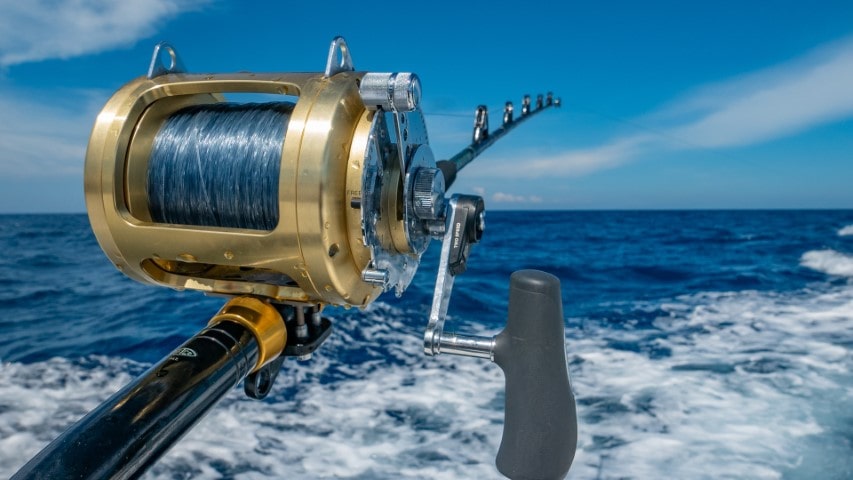
Where Is the Best Saltwater Fishing in Florida?
If we listed all of the great fishing spots in Florida, this blog post would never end, so we chose to share our top 3 favorite sites:
Fort Myers
Fort Myers is an excellent saltwater fishing destination. The abundance of grass flats, mangroves, and water channels provide an ideal environment for a variety of fish. Are you interested in booking a charter boat and exploring what creatures you can find on the Gulf of Mexico? Or, maybe you’d like to try your luck on the Fort Myers Pier, where you can find comfortable benches and a pleasant shade. Want to try something different? Rent a kayak and cast your line, then stay to watch the sunset. The City of Palms offers endless fishing opportunities.
Sanibel Island
Port Sanibel Marina is a great place to start planning your fishing expeditions. In addition to a full-service store and outdoor dining, the marina also offers charter boat rentals and sightseeing tours. The Sanibel Fishing Pier is another popular spot for fishing. There you may also gain valuable advice from other anglers. If you want to switch up the scenery, grab a chair and head to Sanibel Causeway. This popular local spot even offers charcoal grills, so once you’ve caught that king mackerel, you’ll be able to grill it on the spot.
Florida Keys
An excursion to the Florida keys would not be complete without a fishing trip. There’s a reason why Key West is called a fishing paradise. It’s warm all year round, and there are plenty of places to find a catch. In addition, its location between the Atlantic Ocean and the Gulf of Mexico is a significant stopping point for many large migrating species, such as marlin, sailfish, and mahi-mahi.
What Should You Wear on a Deep-Sea Fishing Trip?
To have an enjoyable fishing experience, you must pack adequately. Always bring a wide-brimmed hat that will cover your face and head from the sun’s rays and polarized sunglasses to protect your eyes further. You’ll spend most of your day outdoors, so don’t forget your sunscreen.
It is best to dress in thin layers to prepare for sudden temperature changes when it comes to clothing. Wear a light long-sleeved shirt and breathable shorts to remain comfortable all day. Regardless of what the forecast says, you should always carry a rain jacket or windbreaker in case of unexpected bad weather. To avoid slipping on the deck, make sure to wear non-slippery rubber sole shoes.
What Time of Day Is Best for Deep-Sea Fishing?
Many people prefer fishing when the temperatures are slightly cooler and when the tides are in their favor, generally earlier in the morning or later in the evening. But ultimately, what is the best time to go deep-sea fishing? It’s whenever you can. You will always have a great time, and you will always catch something.
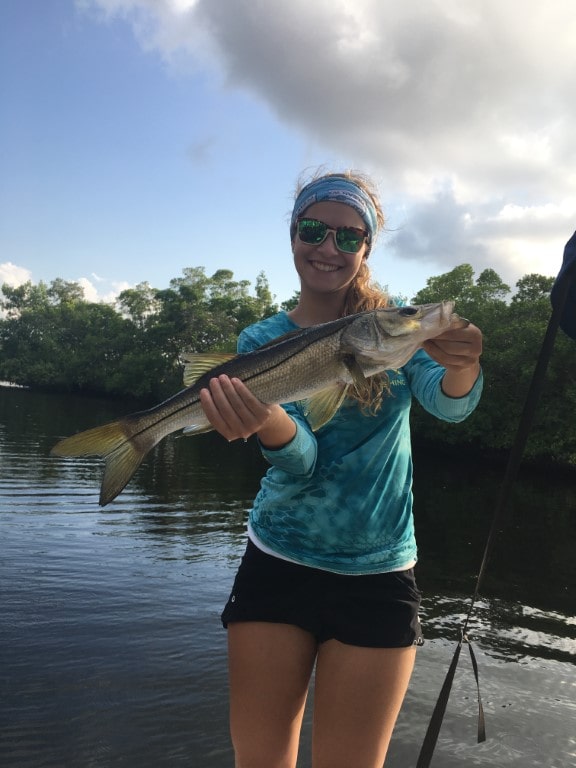
What Fish Can You Catch While Deep-Sea Fishing?
According to local fishing guides and charter captains, there are hundreds of different species of fish you could catch. So, let’s explore a few Florida regions to understand this better.
Fort Lauderdale, Florida
- Tarpon
Also called the silver king, this fish can reach an impressive length of 8 feet, weigh almost 300 pounds, and live up to 50 years. Its remarkable characteristic is that it can live both in fresh and saltwater. - Snook
Snooks can grow up to 50 pounds and cannot survive in temperatures below 60 degrees Fahrenheit. An interesting fact about snooks is that they start life as males, but they transform into females after reaching mature size. - Bass
The bass species can be found in abundance. In addition, these fish are entertaining to catch because of their unpredictable behavior and contentious nature. As a result, the largemouth bass is highly desirable worldwide.
Key West and the Florida Keys
- Marlin
The Atlantic blue female marlin can reach 14 feet in length and 2000 pounds in weight which is about four times larger than an average male. This phenomenal fish is a thrill to catch. As a result of its highly migratory nature, marlins travel great distances throughout the year. - Sailfish
These fish get their name from their massive dorsal fin. They can grow up to 11 feet in length and weigh slightly over 200 pounds. A sailfish can reach 68 miles per hour, making it the fastest fish in the ocean. Due to their enormous size and formidable nature, they are highly sought after by trophy fishers. - Mahi-mahi
In the Hawaiian language, mahi-mahi stands for “very strong,” a description that certainly fits this fish. Although mahi-mahi requires significant effort to catch, the reward is well worth it due to its delicious flavor and beautiful appearance.
- Snapper
Red snapper is among the most popular Florida fish due to its distinct features. It is one of the best-tasting fish and can weigh as much as 30 pounds, making it a favorite to many. As a result, anglers worldwide come to Florida specifically to catch red snapper.
Southwest Florida
- Kingfish
Also known as king mackerel, this fish weighs about 10 pounds on average; however, some reach up to 90 pounds. They are famous for their quickness, fighting ability, rich flavor, and razor-sharp teeth. You could find them in outer reefs and along the coast. - Tuna
The blackfin tuna is the smallest of its species. Typically, their weight ranges from 7 to 40 pounds. However, they are tough fighters and can swim very quickly. The yellowfin tuna grows up to 6 feet long and can weigh up to 200 pounds. Yellowfin, also known as ahi, is commonly found in sushi and poke bowls. - Sheepshead
Even though many of these species weigh less than 5 pounds, you should not underestimate them. Catching them can be challenging due to their sturdy, sharp fins, but the reward is priceless. It’s not every day that you get to see a fish with powerful, human-like teeth. - Shark
You can catch many types of sharks in SW Florida, bull shark, tiger shark, and hammerhead shark, just to name a few. The strength and resilience of these creatures make deep-sea fishing a thrilling and unforgettable experience.
What Part of Florida Has the Best Fishing?
The Sunshine State offers a wide range of locations for saltwater fishing activities. Some people prefer the Florida Keys area, and others prefer Southwest Florida. It depends on what kind of fish you’d like to catch and how you plan to spend your vacation. A fishing trip to Southwest Florida would be ideal for those seeking an island vibe while still having access to a major city. You can change the scenery between Sanibel, Captiva, Fort Myers, Cape Coral, and Naples, and you’ll never get bored.
What Food Should I Bring On a Fishing Trip?
When you book a day fishing trip, remember to always pack food with you. If you’re on a charter boat all day, you’ll probably get hungry at some point, and you don’t want to be in the middle of Florida offshore with no food in sight.
Sandwiches, trail mix, beef jerky, crackers, protein bars, and fruits make excellent choices. They’re packed with nutrients and will keep you full for a while, plus they are easy to carry. In addition, be sure to bring water, sports drinks, and liquids with electrolytes to keep you hydrated in the sun.
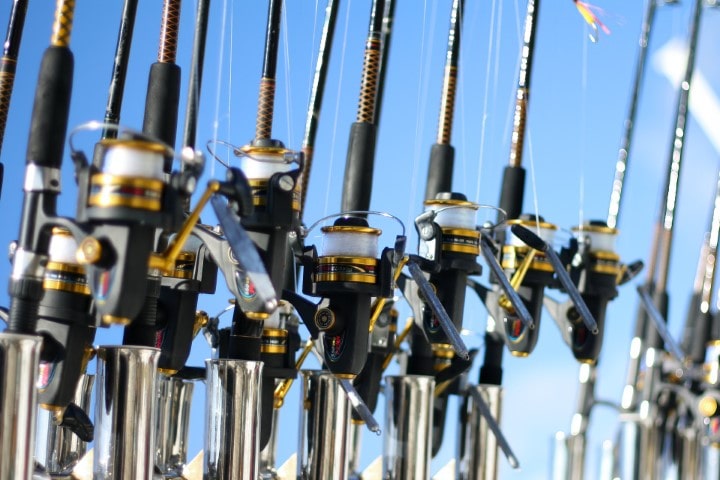
How Do You Avoid Being Seasick during Deep-Sea Fishing?
You can do several things to avoid being seasick when spending the day fishing. We have a few tips for you:
- Prepare physically. When you plan to be on the boat all day, your body needs to be prepared. Avoid drinking dehydrating beverages, such as coffee and alcohol on the day of your fishing trip. Additionally, you should eat light and avoid greasy, heavy food because it might upset your stomach once you hit the waves. Last but not least, a good night’s sleep will give you the energy you need to tackle any ocean creatures.
- Over-the-counter medication. Dramamine is an over-the-counter medication that many people swear by when seasick. It prevents motion sickness, nausea, and dizziness. You can easily find it in your local pharmacy. However, keep in mind that it is an antihistamine, which may cause you to feel drowsy, lightheaded, and less alert. For best results, people take it the night before their trip.
- Products against seasickness. You can try other remedies such as the sea-band wristband or the motion sickness patches. For maximum effectiveness, some people may suggest wearing wristbands on both wrists. Regarding the remedy patch, you should wear it behind the ear to relieve gastrointestinal discomfort and prevent nausea. Please note that the motion sickness patches are not waterproof.
Book Your Next Offshore Experience with Royal Shell Port Sanibel Marina
Southwest Florida is home to some of the best saltwater fishing. If you want to experience the best deep-sea fishing in Florida, make sure to book with the Charter Captains at Royal Shell Port Sanibel Martina. They have complete knowledge of the waterways and fish migration routes and provide you with the best fishing opportunities. So whether you’re looking to catch a shark or tarpon, we’ve got you covered.
